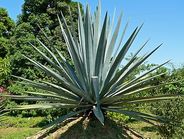 Blue Agave (Agave tequilana)
Blue Agave (Agave tequilana) I have never used agave syrup and someone asked me what my thoughts are on the product. Let me share what I have found out. You've seen agave syrup in your grocery store or in products sweetened with it's nectar. It's about 1.5 times sweeter than sugar and comes from the same plant that is used to make tequila.
Is it better than sugar, honey, or maple syrup? Are there benefits to using it if you are losing weight or have diabetes?
The answer may be more about your personal taste than about health. If you were hoping that you could use as much agave as you like, that's unfortunately not the case.
What Is Agave?
The agave plant grows in the southwestern U.S. and through the northern part of South America. Most agave sweeteners come from the blue agave plant. It's not the raw nectar, it's highly processed before you can add it to your tea, top your pancakes with it, or get it in an energy drink, bar, or other product.
Agave syrup, is considered a low-glycemic, product and may not have a lot of glucose, but it's has a high percent of fructose and in some cases even higher than high-fructose corn syrup. It's one and a half times sweeter than sugar so you should theoretically use less of it, you still need to be careful. Too much means too many calories and too much fructose and all the health risks associated with that....Read More
The American Heart Association recommends limiting sweeteners to no more than 6 teaspoons for women and 9 teaspoons for men per day, on average. That includes all sources, whether it's agave, sugar, high-fructose corn syrup, or anything else.
Health Impact
Due to its high fructose levels, agave syrup has the potential to lead to insulin resistance and significantly increased triglyceride levels (a risk factor for heart disease).
Sources:
wikipedia.org/wiki/Agave_nectar
http://www.webmd.com
Is it better than sugar, honey, or maple syrup? Are there benefits to using it if you are losing weight or have diabetes?
The answer may be more about your personal taste than about health. If you were hoping that you could use as much agave as you like, that's unfortunately not the case.
What Is Agave?
The agave plant grows in the southwestern U.S. and through the northern part of South America. Most agave sweeteners come from the blue agave plant. It's not the raw nectar, it's highly processed before you can add it to your tea, top your pancakes with it, or get it in an energy drink, bar, or other product.
Agave syrup, is considered a low-glycemic, product and may not have a lot of glucose, but it's has a high percent of fructose and in some cases even higher than high-fructose corn syrup. It's one and a half times sweeter than sugar so you should theoretically use less of it, you still need to be careful. Too much means too many calories and too much fructose and all the health risks associated with that....Read More
The American Heart Association recommends limiting sweeteners to no more than 6 teaspoons for women and 9 teaspoons for men per day, on average. That includes all sources, whether it's agave, sugar, high-fructose corn syrup, or anything else.
Health Impact
Due to its high fructose levels, agave syrup has the potential to lead to insulin resistance and significantly increased triglyceride levels (a risk factor for heart disease).
Sources:
wikipedia.org/wiki/Agave_nectar
http://www.webmd.com
 RSS Feed
RSS Feed
